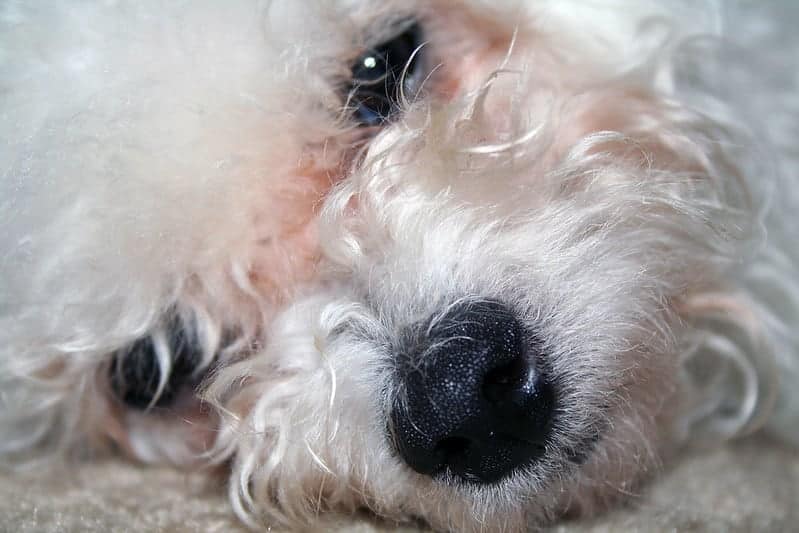
This iconic powderpuff of a dog is an undeniable pet. Happy to play fetch in the mud until the sun sets, before heading home for a luxurious wash and blow-dry, the Bichon Frise is a great all-rounder of a dog.
So, it begs the question: what were Bichon Frise bred for? What are this small white dog’s origins? Are they as fancy and intelligent as a small Poodle? Or are they as goofy as a fluffy Pug? Let’s take an in-depth look at this fluffball’s past:
Why were Bichon Frise bred?
Today a popular family dog and guide dog, the Labrador Retriever was first bred to retrieve nets and otherwise help fishermen. Dogs like the Doberman and Schnauzer still know that they were first developed as guard dogs, even the miniature ones. But why were Bichon Frise first bred?
Well, this small Poodle-like breed’s earliest origins are unclear. However, the Bichon Frise does seem to have been bred as a companion dog. As far back as the 13th century, Bichon Frises have been documented as associating with the nobles of France, Italy, and Spain. Even during the Renaissance, many a Bichon was immortalized in paint!
Today, as a pet, the Bichon Frise continues to delight families up and down the country with their playful antics and inimitable dancing. These curly-haired fluffballs are also now bred for showing at Cruft’s and Kennel Club events around the globe!
What are Bichon Frise known for?
One of the main things the Bichon Frise is known for is their jovial, playful outlook on life. Sure, they may sometimes swing their toys around harshly, or bark at the postie or an empty food bowl, but even this is done with a constant panting smile and a wag of their tail.
The next thing the Bichon Frise does better than any other dog is their dancing. Perhaps channeling their past in the circus ring, Bichons are constantly spinning and hopping around on their hind legs. Not only does it look cute, but the Bichon’s dance also helps them communicate with you!
The Bichon Frise also makes a good watchdog. Bichon Frises are alert, and to make up for their small size, they’ll seek a good vantage point in your home. The more they can see, the better. And when they do see something interesting, a Bichon will bark with their nose up to the sky, before bringing it down to check whether the thing is still there.
Friend and your Bichon Frise will start spinning rapidly! Foe, your Bichon will either run away or bravely defend the home.
And then there’s the Bichon Frise’s friendly personality. They may not be that interested in other dogs, but Bichon Frises love all people, especially people who will pet them and pamper them like the royalty they once were. A Bichon Frise greets all people with a dizzying spin and maybe even a hind leg hop!

BICHON FRISE PET INSURANCE
- Injuries
- Surgeries
- Cancer
- Prescribed Medications
- Annual Checkups
What is the history of the Bichon Frise?
The Bichon Frise has a long history. The Bichon Frise’s most ancient ancestor was the “Tenerife Teria” or the “Bicho”. This small white dog was found in the Mediterranean region.
This first Bichon was probably a descendent of the Barbet, or water spaniel. In the 15th century, the jolly Bicho swam after the boats of the sailors and pirates to the Canary Islands and Spanish mainland. These early Bichon Frises were used for bartering, in exchange for other commodities.
Later on, the Bichon Frise had to work to earn their keep, at least in France. You’ve probably noticed the way Bichons are seemingly born dancing, and so did the people of the streets of France. Street entertainers began to adopt the Bichon Frise as a playful, boisterous circus performer.
These fluffy canine clowns would walk around the big top on their hind legs, waving both their paws in the air. They would also spin around the streets, hopefully persuading passers-by to toss them some change.
As the 20th century came, and the Societé Centrale Canine of France began to rescue the Bichon Frise from the streets, this distinct category of fluffy dog became known as the “Bichon a Poil Frise” – the Bichon with curly coat. These fluffballs then made their way to America – travelling by air this time! – thanks to Helene and Francois Picault of Dieppe, France.
In 1956, the pair arrived with six Bichon Frises. Soon, the first American Bichon Frise litter was born. The Bichon breed’s small yet diehard group of fans set about establishing paramount traits like the breed’s small size, as well as that goofy facial expression you know and love. It wasn’t long before the first official Bichon Frise Club of America was founded in San Diego, in 1964.
Just a few years later, in 1973, the AKC formally accepted the Bichon Frise breed into the Non-Sporting Group. Now that the breed could be shown, it gained even more popularity! Since then, more and more Bichons have taken home more and more medals.
Is a Bichon Frise a good first dog?
Well, the Bichon Frise undoubtedly has a friendly, people-oriented personality. What’s more, is, they’re anxious to please their favorite people, which makes them very easy to train. And yet, they can be independent, only needing attention when they request it. Bichon Frises also have a non-shedding, hypoallergenic coat. These small dogs don’t need that much exercise, either
However, this small dog doesn’t tolerate rough handling by young children in the slightest, and can be quick to snap, even if a child only wants to play with them or pet them.
Plus, their non-shedding coat also comes with the distinct disadvantage of requiring loads of care, lest it become matted and clumped (this can happen quickly if you’re not careful). You’ll practically have to set up a mini home dog parlor with all the brushing that’s required!
On top of this, many owners report that Bichon Frises can be stubborn when it comes to house-breaking or potty training. Ultimately, it’s up to you to weigh up the advantages and disadvantages of the Bichon Frise’s personality and care needs and see how well the breed suits your situation and lifestyle.


